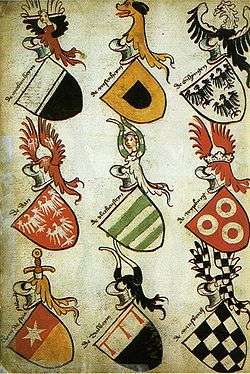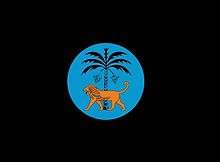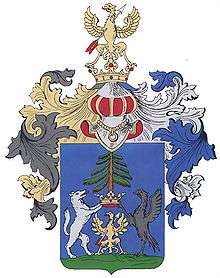Coat of arms
A coat of arms is an heraldic visual design on an escutcheon (i.e., shield), surcoat, or tabard. The coat of arms on an escutcheon forms the central element of the full heraldic achievement which in its whole consists of shield, supporters, crest, and motto. A coat of arms is traditionally unique to an individual person, family (except in the United Kingdom), state, organisation or corporation.
| Part of a series on |
| Heraldic achievement |
|---|
| Conventional elements of coats of arms |
|
|
History
Background
The ancient Greek hoplites used individual insignia on their shields.[3] The ancient Romans used similar insignia on their shields, but these identified military units. The first evidence of medieval coats of arms has been attributed to the 11th century Bayeux Tapestry in which some of the combatants carry shields painted with crosses. However, that heraldic interpretation remains controversial.
Heraldry
Coats of arms came into general use by feudal lords and knights in battle in the 12th century. By the 13th century, arms had spread beyond their initial battlefield use to become a flag or emblem for families in the higher social classes of Europe, inherited from one generation to the next. Exactly who had a right to use arms, by law or social convention, varied to some degree between countries. In the German-speaking regions both the aristocracy and "burghers" (non-noble free citizens) used arms, while in most of the rest of Europe they were limited to the aristocracy. The use of arms spread to the clergy, to towns as civic identifiers, and to royally chartered organizations such as universities and trading companies. Flags developed from coats of arms, and the arts of vexillology and heraldry are closely related. The coats of arms granted to commercial companies are a major source of the modern logo.
Despite no widespread regulation, heraldry has remained consistent across Europe, where tradition alone has governed the design and use of arms. Some nations, like England and Scotland, still maintain the same heraldic authorities which have traditionally granted and regulated arms for centuries and continue to do so in the present day. In England, for example, the granting of arms is and has been controlled by the College of Arms. Unlike seals and other general emblems, heraldic "achievements" have a formal description called a blazon, which uses vocabulary that allows for consistency in heraldic depictions. In the present day, coats of arms are still in use by a variety of institutions and individuals: for example, many European cities and universities have guidelines on how their coats of arms may be used, and protect their use as trademarks.[4][5] Many societies exist that also aid in the design and registration of personal arms.
Traditions and usage

In the heraldic traditions of England and Scotland, an individual, rather than a family, had a coat of arms. In those traditions coats of arms are legal property transmitted from father to son; wives and daughters could also bear arms modified to indicate their relation to the current holder of the arms. Undifferenced arms are used only by one person at any given time. Other descendants of the original bearer could bear the ancestral arms only with some difference: usually a colour change or the addition of a distinguishing charge. One such charge is the label, which in British usage (outside the Royal Family) is now always the mark of an heir apparent or (in Scotland) an heir presumptive. Because of their importance in identification, particularly in seals on legal documents, the use of arms was strictly regulated; few countries continue in this today. This has been carried out by heralds and the study of coats of arms is therefore called "heraldry". In time, the use of arms spread from military entities to educational institutes, and other establishments.[4]
In his book, The Visual Culture of Violence in the Late Middle Ages, Valentin Groebner argues that the images composed on coats of arms are in many cases designed to convey a feeling of power and strength, often in military terms.[6] The author Helen Stuart argues that some coats of arms were a form of corporate logo.[7] Museums on medieval armoury also point out that as emblems they may be viewed as precursors to the corporate logos of modern society, used for group identity formation.[8]
When knights were encased in armour that no means of identifying them was left, the practice was introduced of painting their insignia of honour on their shield as an easy method of distinguishing them. Originally these were granted only to individuals, but were afterward made hereditary in England by King Richard I, during his crusade to the Holy Land.
European tradition
French and British heraldry


The French system of heraldry greatly influenced the British and Western European systems. Much of the terminology and classifications are taken from it. However, with the fall of the French monarchy (and later Empire) there is not currently a Fons Honorum (power to dispense and control honors) to strictly enforce heraldic law. The French Republics that followed have either merely affirmed pre-existing titles and honors or vigorously opposed noble privilege. Coats of arms are considered an intellectual property of a family or municipal body. Assumed arms (arms invented and used by the holder rather than granted by an authority) are considered valid unless they can be proved in court to copy that of an earlier holder.
In Scotland, the Lord Lyon King of Arms has criminal jurisdiction to control the use of arms. In England, Northern Ireland and Wales the use of arms is a matter of civil law and regulated by the College of Arms and the Court of Chivalry.
In reference to a dispute over the exercise of authority over the Officers of Arms in England, Arthur Annesley, 1st Earl of Anglesey, Lord Privy Seal, declared on 16 June 1673 that the powers of the Earl Marshal were "to order, judge, and determine all matters touching arms, ensigns of nobility, honour, and chivalry; to make laws, ordinances, and statutes for the good government of the Officers of Arms; to nominate Officers to fill vacancies in the College of Arms; to punish and correct Officers of Arms for misbehaviour in the execution of their places". It was further declared that no patents of arms or any ensigns of nobility should be granted and no augmentation, alteration, or addition should be made to arms without the consent of the Earl Marshal.
Irish heraldry
In Ireland the usage and granting of coats of arms was strictly regulated by the Ulster King of Arms from the office's creation in 1552. After Irish independence in 1922 the office was still functioning and working out of Dublin Castle. The last Ulster King of Arms was Sir Nevile Rodwell Wilkinson [Ulster King of Arms 1908–1940], who held it until his death in 1940. At the Irish government's request, no new King of Arms was appointed. Thomas Ulick Sadleir, the Deputy Ulster King of Arms, then became the Acting Ulster King of Arms. He served until the office was merged with that of Norroy King of Arms in 1943 and stayed on until 1944 to clear up the backlog.
An earlier Ireland King of Arms was created by King Richard II in 1392 and discontinued by King Henry VII in 1487. It didn't grant many coats of arms – the few it did grant were annulled by the other Kings of Arms because they encroached upon their jurisdictions. Its purpose was supposedly to marshal an expedition to fully conquer Ireland that never materialized. Since 1 April 1943 the authority has been split between the Republic of Ireland and Northern Ireland. Heraldry in the Republic of Ireland is regulated by the Government of Ireland, by the Genealogical Office through the Office of the Chief Herald of Ireland. Heraldry in Northern Ireland is regulated by the British Government by the College of Arms through the Norroy and Ulster King of Arms.
German and Scandinavian heraldry

The heraldic tradition and style of modern and historic Germany and the Holy Roman Empire — including national and civic arms, noble and burgher arms, ecclesiastical heraldry, heraldic displays, and heraldic descriptions — stand in contrast to Gallo-British, Latin and Eastern heraldry, and strongly influenced the styles and customs of heraldry in the Nordic countries, which developed comparatively late.[9]
In the Nordic countries, provinces, regions, cities, and municipalities have coats of arms. These are posted at the borders and on buildings containing official offices, as well as used in official documents and on the uniforms of municipal officers. Arms may also be used on souvenirs or other effects, given that an application has been granted by the municipal council.
Other European countries
At a national level, "coats of arms" were generally retained by European states with constitutional continuity of more than a few centuries, including constitutional monarchies like Denmark as well as old republics like San Marino and Switzerland.
In Italy the use of coats of arms was only loosely regulated by the states existing before the unification of 1861. Since the Consulta Araldica, the college of arms of the Kingdom of Italy, was abolished in 1948, personal coats of arms and titles of nobility, though not outlawed, are not recognised.
Coats of arms in Spain were generally left up to the owner themselves, but the design was based on military service and the heritage of their grandparents. In France, the coat of arms is based on the Fleur-de-lys and the Rule of Tinctures used in English heraldry as well.
Among the states ruled by communist regimes, emblems resembling the Soviet design were adopted in all the Warsaw Pact states except Czechoslovakia and Poland. Since 1989, some of the ex-Communist states, as Romania or Russia have reused their original pre-communist heraldry, often with only the symbols of monarchy removed. Other countries such as Belarus or Tajikistan have retained their communist coats of arms or at least kept some of the old heraldry.
Asia and Africa
Japanese emblems, called kamon (often abbreviated "mon"), are family badges which often date back to the 7th century, and are used in Japan today. The Japanese tradition is independent of the European, but many abstract and floral elements are used.
Sometimes simple items express an origin to a specific design. An example in recent use is the logo of Mitsubishi corporation which started as a shipping and maritime enterprise and whose emblem is based on a water chestnut derived from its maritime history with a military naval influence. The word mitsu means the number 3 and the word hishi meaning "water chestnut" (pronounced bishi in some combinations; see rendaku) originated from the emblem of the warrior Tosa Clan. The battleships of the Tosa Clan had been used in the late 19th century in the First Sino-Japanese War to reach Korea[10] and their name was given to a modern battleship. The Tosa water chestnut leaf mon was then drawn as a rhombus or diamond shape in the Mitsubishi logo.[11][12]

.svg.png)

With the formation of the modern nation states of the Arab World in the second half of the 20th century, European traditions of heraldry were partially adopted for state emblems. These emblems often involve the star and crescent symbol taken from the Ottoman flag. Another commonly seen symbol is the eagle, which is a symbol attributed to Saladin,[13] and the hawk of the Qureish. These symbols can be found on the Coat of Arms of Egypt and Syria.
New World practices
.svg.png)
The Queen of Canada has delegated her prerogative to grant armorial bearings to the Governor General of Canada. Canada has its own Chief Herald and Herald Chancellor. The Canadian Heraldic Authority is situated at Rideau Hall.[14][15] The Great Seal of the United States uses on the obverse as its central motif an heraldic achievement described as being the arms of the nation.[16] The seal, and the armorial bearings, were adopted by the Continental Congress on 20 June 1782, and is a shield divided palewise into thirteen pieces, with a blue chief, which is displayed upon the breast of an American bald eagle. The crest is thirteen stars breaking through a glory and clouds, displayed with no helm, torse, or mantling (unlike most European precedents). Only a few of the American states have adopted a coat of arms, which is usually designed as part of the respective state's seal. Vermont has both a state seal and a state coat of arms that are independent of one another (though both contain a pine tree, a cow and sheaves of grain); the seal is used to authenticate documents, whilst the heraldic device represents the state itself.
Ecclesiastic practice

The Vatican City State and the Holy See each have their own coat of arms. As the papacy is not hereditary, its occupants display their personal arms combined with those of their office. Some popes came from armigerous (noble) families; others adopted coats of arms during their career in the Church. The latter typically allude to their ideal of life, or to specific pontifical programmes.[17] A well-known and widely displayed example in recent times was Pope John Paul II's arms. His selection of a large letter M (for the Virgin Mary) was intended to express the message of his strong Marian devotion.[18] Roman Catholic dioceses are also each assigned a coat of arms, as are basilicas or papal churches, the latter usually displaying these on the building. These may be used in countries which otherwise do not use heraldic devices. In countries like Scotland with a strong statutory heraldic authority, arms will need to be officially granted and recorded.
Flags and banners
Flags are used to identify ships (where they are called ensigns), embassies and such, and they use the same colors and designs found in heraldry, but they are not usually considered to be heraldic. A country may have both a national flag and a national coat of arms, and the two may not look alike at all. For example, the flag of Scotland (St Andrew's Cross) has a white saltire on a blue field, but the royal arms of Scotland has a red lion within a double tressure on a gold (or) field.
Gallery
See also
- Arms of assumption
- National emblem
- Seal
- Insignia
- List of coats of arms
- Baron and feme
- Siebmachers Wappenbuch (Coats of arms from Germany, Switzerland, Austria, etc.)
Notes
- ↑ A.G. Puttock, A Dictionary of Heraldry and Related Subjects, Exeter 1985. Blaketon Hall. ISBN 0 907854 93 1. P. 40
- ↑ Stephen Friar (ed.), A New Dictionary of Heraldry, London 1987. Alphabooks/A&C Black. ISBN 0-906670-44-6. P. 96.
- ↑ George H. Chase, Shield Devices of the Greeks, Harvard Studies in Classical Philology, Vol. 13 1902
- 1 2 "Educational Institute Coat of arms". October 2005. Retrieved 26 August 2015.
- ↑ "Policy on use of the Workmark and Insignia of McGill University" (PDF). 2000. Archived from the original (PDF) on 26 February 2015. Retrieved 26 August 2015.
- ↑ Valentin Groebner, 2004, The Visual Culture of Violence in the Late Middle Ages ISBN 978-1-890951-37-5
- ↑ Employee Identification with the Corporate Identity International Studies of Management and Organization, Volume 32, Number 3, 2002
- ↑ "Group Identity Formation in the German Renaissance". 20 August 2002. Retrieved 26 August 2015.
- ↑ Volborth, Carl-Alexander von (1981). Heraldry: Customs, Rules and Styles. Poole, England: Blandford Press. ISBN 0-7137-0940-5. ISBN 0-7137-0940-5 p.129.
- ↑ Donald Calman, 1992 The Nature and Origins of Japanese Imperialism ISBN 0-415-06710-3
- ↑ "Mitsubishi Mark". 2015. Retrieved 26 August 2015.
- ↑ "Mitsubishi History". 2015. Retrieved 26 August 2015.
- ↑ "Coat of Arms (Eagle of Saladin)". Macaulay Honors College. 5 April 2011. Retrieved August 19, 2015.
- ↑ "The History of Heraldry in Canada". Royal Heraldry Society of Canada. 28 April 2004. Retrieved 2008-08-21.
- ↑ "The Canadian Heraldic Authority". Canadian Heraldic Authority. 2015. Retrieved 2015-08-26.
- ↑ "2004 Seal Broch" (PDF). July 2003. Retrieved 26 August 2015.
- ↑ "Coat of arms of His Holiness Benedict XVI". 2015. Retrieved 26 August 2015.
- ↑ "Vatican press office". 9 June 2013. Retrieved 27 August 2015.
References
- Pimbley, Arthur Francis (1908). Pimbley's dictionary of heraldry. Pimbley.
 This article incorporates text from a work in the public domain: "Pimbley's dictionary of heraldry", Arthur Francis Pimbley (1908)
This article incorporates text from a work in the public domain: "Pimbley's dictionary of heraldry", Arthur Francis Pimbley (1908)
External links
| Wikimedia Commons has media related to Coats of arms. |
| Wikisource has original text related to this article: |
| Wikidata has the property: coat of arms (P237) (see uses) |
- College of Arms: Repository of the coats of arms and pedigrees of English, Welsh, Northern Irish and Commonwealth families and their descendants together with, and in principle under the control of, the legal body the Court of Chivalry, both medieval in origin.
- The Court of the Lord Lyon: the statutory heraldry office for Scotland
- Royal Dutch Library page for the "Wapenboek Beyeren" written by Claes Heynenzoon around 1400, containing over 1000 drawings of coats of arms
- General armorial of noble families in the Russian Empire (Gerbovnik)




